Scan. Dismiss. Scan. Dismiss. Scan …click!
This is what your audience is doing today. This is what we’re all doing today. In our inbox, on social media and on blogs, we scan through headlines, dismissing most and clicking a few.
Winning that click depends on the headline, more than anything else. It’s impossible to overstate their importance. We are all judged instantly and ruthlessly by this short set of words.
The average person sees 1,300+ headlines each day and dismisses 99.7% of them.*
*Totally fabricated, but a great headline.
Even if you do everything else right, blogging your fingers to the bone, everything will fail if you get this one thing wrong.
So here are our headline best practices. Let’s look at all the places they appear and how the success factors vary…
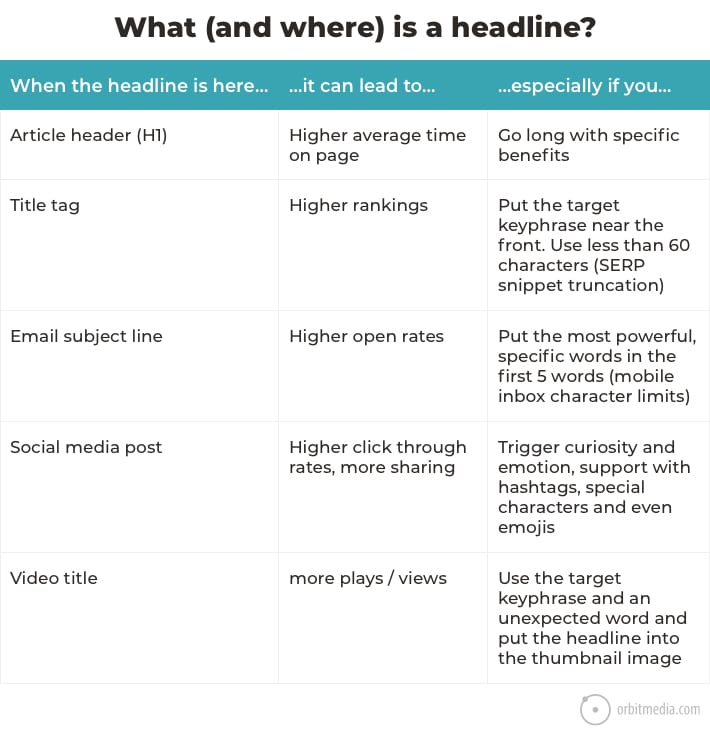
So a great headline isn’t just one thing. A single article may have different headlines in different places. It’s adapted for each context. Do not try to make one size fit all.
Now on to the checklist for writing great headlines.
1. Make a promise. Be specific.
The key to the click is to understand this: Before any of us click anything, we do a split second cost-benefit calculation.
Is the benefit of clicking (the value of the content) higher than the cost (two seconds of my time)?
Here’s what’s happening in your visitor’s brain…
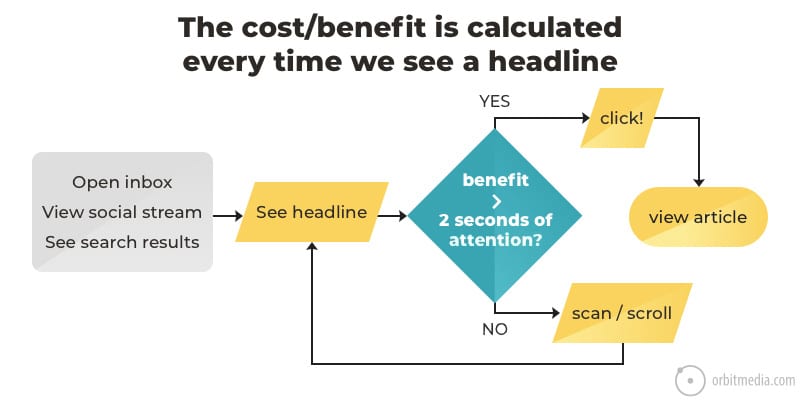
The job of the headline is to indicate the benefit and to make a promise to the visitor that it’s worth it. And to do it in less than a second.
The more specific the benefit, the more likely the visitor is to click. Great headlines make specific promises.
Ask yourself as if you’re the reader. “What’s in it for me?” The answer should jump off the page. If it doesn’t, get ready to hear crickets. You’re about to fail.
The ability to imagine the readers’ perspective is the key to success in writing headlines. Empathy is the greatest marketing skill.
 |
Charlie Meyerson, Award-winning journalist“Assume your audience isn’t interested. Write a headline that spotlights the most compelling, most irresistible part of your content.” |
 |
Barry Feldman, Feldman Creative“The pulling power of a magnetic headline traces to its promise. Simply stated, it’s a benefit.” |
 |
Jeff Goins, Goings, Writer“Every headline needs to offer a promise that the body copy delivers on. I don’t know about you, but I like my promises to be more than vanilla. They need to sound like amazing opportunities. Otherwise, they’re not much of a promise. The way to capture attention is to employ powerful words in your headline that get the reader excited to read the whole article.” |
2. Use power trigrams
A few years back, Steve Rayson of Buzzsumo did a study to learn what makes effective headlines, and what correlates with social media engagement. His research was different in two ways. First, he looked at a LOT of data: 100,000,000 headlines. Second, he looked at trigrams, which are groups of three words.
As it turns out, certain trigrams have huge correlations with social engagement.
This chart shows the average number of Facebook likes, comments and shares for headlines that include these trigrams.
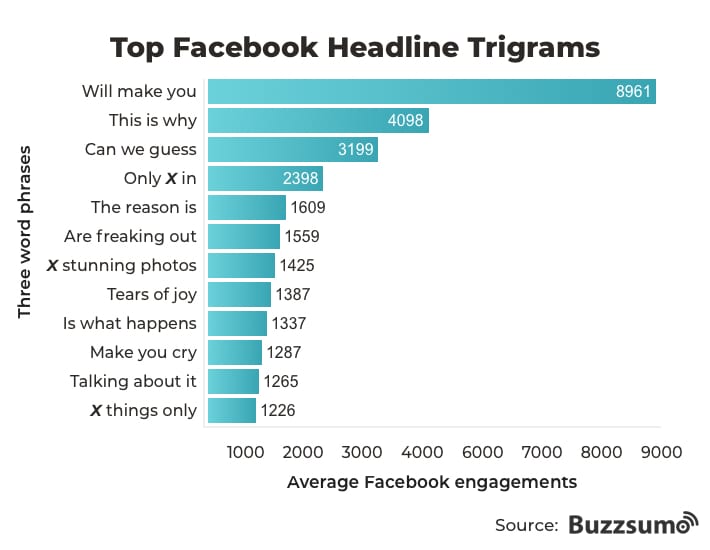
When these trigrams appear at the beginning of headlines, the headline is much more likely to get social engagement…
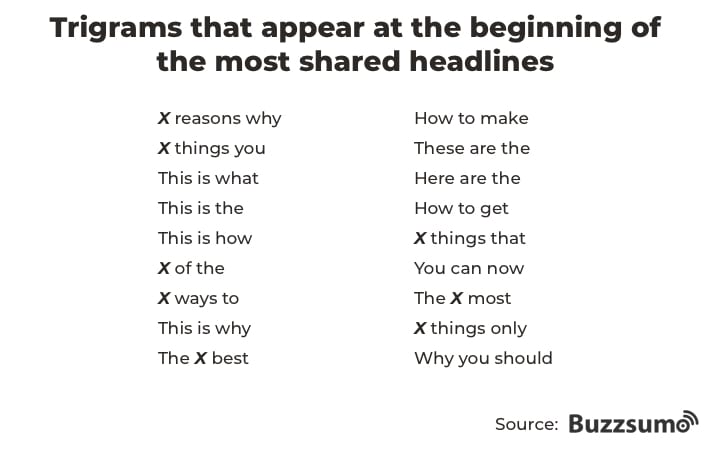
Warning! No clickbait!
If your first reaction is “this is clickbait” please keep reading. I am not recommending writing clickbait headlines. Do not try to trick the reader. Your article must deliver on the promise in the headline.
 |
Ann Handley, Chief Content Officer, Marketing Profs, Author of “Content Rules” and “Everybody Writes”“The key is to keep yourself honest and use such headlines only when they are helpful triggers for your audience. So go ahead and use “14 Surprising Ways You Can Grow Pumpkins,” but only if the 14 ways might indeed be surprising to your audience. In the same vein, “14 Different Pumpkin Plants That Will Grow in Ridiculously Small Containers” will work only if the said containers actually are, well, ridiculously small.” |
But look closely at these trigrams and you can see why they work so well. They all make promises. If you’re writing blog headlines that include these trigrams, you’re offering specific benefits to the reader.
Example:
- This is why these x stunning photos will make you cry tears of joy
That one’s a joke. I simply combined a bunch of the top performing trigrams. It doesn’t even make sense.
3. Use numbers
List posts are popular for a reason: they set expectations about the amount of content, about scan-ability and variety; if you don’t like one thing, you’ll be able to scan down and find something else.
Numerals, not just numbers, are part of the magic. In a line of letters, numerals stand out. So don’t write a headline with “Eight Things,” write a headline with “8 things.”
Headlines with numbers aren’t always list posts. Numbers can also be data and statistics, indicating that the article is supported by research. LinkedIn tested headlines with and without statistics and found that stats had a big impact on click through rates.

 |
Megan Golden, LinkedIn“At LinkedIn, there’s not a campaign that leaves our hands that doesn’t have some aspect of A/B testing. Oftentimes, tests reveal that the smallest tweaks can make the greatest performance impact. Using data or stats, especially up front, can imply instant credibility to your post or headline” |
Examples:
- 17 Social Media Books That Will Make You a Smarter Marketer
- How to Increase Conversion Rates by 529%
- 101 Ways to Write Top 10 Lists that Increase Traffic By 21%
You get the idea.
 |
Sonia Simone, Chief Marketing Officer, Copyblogger“Don’t buy the argument that “those headline formulas don’t work any more” All that old “cheesy” advice can still be remarkably effective. Make sure there’s a benefit to the reader in the headline — something that person will get out of reading the content. Numbers in the headline still work. List posts still work. The secret to staying out of Cheeseland? Make the content *behind* your headline amazing. Put some love (and work) into it, to make it compelling and genuinely useful. Bring your own unique writing voice and sincere care for the topic into your written, audio, and video content.” |
4. Ask a question
Question headlines have two benefits. First, they leverage a psychological effect, causing the reader’s mind to take the next step: answer the question …or wonder. The lack of completeness inherent in questions causes tension and interest in readers.
Search is the second benefit. Google is focused on the meaning of a search query, not just combinations of words. It’s called “latent semantic indexing” and it’s key to Semantic SEO. The natural language of a complete question helps Google understand how the article is useful.
People are using their voices, not just fingers, to search these days. And naturally, they’re asking complete, full-sentence questions. Complete questions and answers help Google connect people to your content.
Examples:
- Why Do Dogs Bark at Night? 5 Dog Trainers Offer Tips for Quiet Canines.
- Which Superhero Are You? Take This Short Quiz and Find Out….
- How Does Social Media Affect SEO? (this was a recent post/video on this blog)
 |
Heidi Cohen, Actionable Marketing Guide“The power of question headlines comes from tapping into what keeps your readers up at night. Increase your question title’s effectiveness by making it personal. Include the word “you.” The drawback of question titles is that its open-ended nature loses some clarity. This can hinder title performance. So when I use a question title, I use the subtitle to clarify any open points.” |
5. Put impact words at the front of your headline
In the mobile inbox, subject lines get truncated after just 45 or so characters. In search results, title tags get truncated after around 60 characters. Podcast titles have the same issue.
Consider these examples. These are really the same headline:
- 10 Simple Communication Tips That Can Help You Ace Your Job Interview
- How to Ace Your Job Interview with These 10 Simple Communication Tips
But here’s how they look in the mobile inbox:
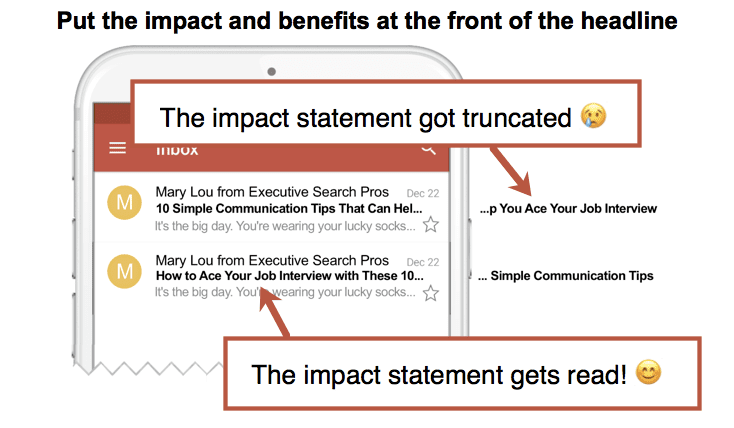
One subscriber sees the impact and benefit of clicking right there in the inbox: “ace your job interview.” The other would have to open the email to see that benefit statement. Here are a few more tips for increasing email open rates.
 |
Charlie Meyerson, Award-winning journalist“Place the story’s most interesting word or phrase as close as possible to the start of the headline. This becomes even more crucial as people read on their smartphones, where email subject lines can get truncated to 3 or 4 words.” |
Even when truncation isn’t an issue, readers will scan your headline from the beginning. So put those thumb-stopping words toward the front make them more likely to be seen, more likely to get tapped.
6. Write very long headlines
So it’s front-loaded with impact words and benefits, but that doesn’t mean that the headline itself is short. According to that same research by Steve Rayson, long headlines are winning, at least in Facebook.
This chart shows the average number of Facebook engagements based on the number of words in headlines.
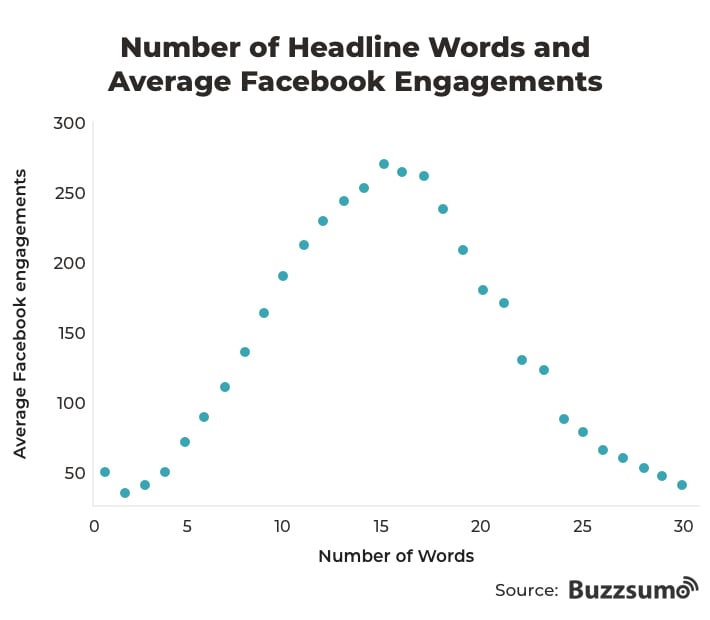
That’s right. 15-word headlines had the highest average number of interactions. I suspect that most marketers have never written a headline that long. Try it and you’ll find yourself writing long, complete sentences. Or maybe two sentences.
Check out these examples from some viral content sites:
- It is now legal to breastfeed in public in all 50 states. Just now. In 2018. (16 words)
- Incredibly Unfair: Even Though Billionaires Work Way Harder Than Everyone Else, Then Only Earn 4,000 Times As Much Money (19 words)
- Devastating: Kid Makes the ‘Pull Horn’ Sign But the Trucker Accidentally Pulls the Self Destruct Cord (16 words)
It makes sense since the longer the headline the more likely the reader is to find and understand the benefit to clicking.
Give it a try.
We recommend going long wherever truncation isn’t an issue. That’s social posts and <h1> tags (page headers). It won’t work for title tags or subject lines. Those will always be truncated by Google and inbox providers.
7. Put the keyword first
Also good at the front of the headlines: target keyphrases.
Using the target keyphrase at the beginning of the title tag <title> and header <h1> gives it “keyphrase prominence” helping to indicate its relevance to search engines. This is not important for subject lines and social posts.
An effective headline works for both search engines and readers. To create headlines that rank and capture attention, use a colon. This lets you separate the search-friendly keyword from the social-friendly triggers.
It gives you keyphrase prominence but still leverages human psychology in the rest of the headline.
Check out these examples from past posts on this blog:
- How to Research Keywords: A Step-by-Step Process (with video)
- Neuromarketing Web Design: 15 Ways to Connect with Visitors’ Brains
- 3 Internal Linking Strategies for SEO and Conversions
- What to Blog About: 17 Source of Fresh Blog Topics
See the pattern? Each post is optimized to rank for the phrase at the beginning of the headline (with perfect keyphrase prominence) followed by a number or words to connect with visitors’ hearts and minds.
So here’s Orbit’s formula for headlines:
Target Keyphrase + Colon + Number or Trigger Word + Promise
Does it work? Search for any of those phrases before the colon in the headlines above. You probably see the post ranking for the phrase …and you might just click, thanks to the numbers and the benefit statements.
Final tip: Write lots, choose one.
The pros aren’t writing a headline. They are writing lots of headlines. For any article, you should write a dozen or more. Write several options for each location: title tags, headers and subject lines. Meet with your editor or get input from a friendly marketer.
Once you’ve got a dozen or more, you can pick one and put the rest in the circular file (the trash).
Here are a few final examples of headlines. These are the ones we considered but didn’t use for this article…
- A Quick Guide to Killer Headlines That Readers Can’t Resist
- How to Write Headlines That Won’t Get Ignored (Our 7-Point Checklist)
- 7 Headline Writing Rules For More Clicks, Traffic and Shares
- X Catchy Headlines, And 7 Tips for Writing Powerful Headlines Yourself
What do you think? Should we have gone with any of these?
The post How to Write Great Headlines: 21 Creative Headline Examples appeared first on Orbit Media Studios.
from Orbit Media Studios https://www.orbitmedia.com/blog/writing-headlines/
via IFTTT
from
https://sarahbarnett0.wordpress.com/2020/05/20/how-to-write-great-headlines-21-creative-headline-examples/
No comments:
Post a Comment